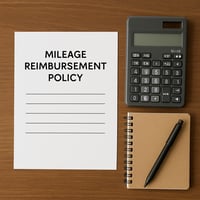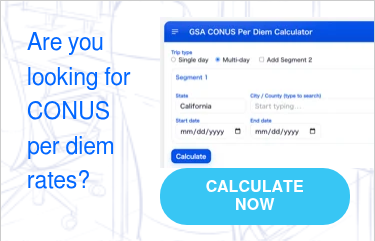
2026 Mileage Rates: Updates, Delays & Compliance Tips
Every year, organizations across the U.S. brace for the annual mileage rate update from the IRS and GSA. These figures guide how businesses reimburse employees for travel, determine per diem allowances, and maintain compliance with federal standards.
As of today, November 3, 2026, the IRS has not yet released the 2026 standard mileage rates, and the U.S. General Services Administration (GSA) has not published its Foreign and Non-Foreign OCONUS Per Diem rates. While it’s not unusual for updates to arrive in December, this year’s timing highlights why centralizing and automating rate management matters.
Why Mileage Rates Matter

Mileage rates might seem like small numbers, but they drive significant cost and compliance implications across finance and HR departments.
The IRS standard mileage rate defines how much employers can reimburse tax-free for business use of a personal vehicle. It’s adjusted annually to reflect changes in fuel, maintenance, insurance, and depreciation costs.
For reference:
-
2024 IRS business rate: 67¢ per mile
The GSA per diem rates—which cover daily allowances for lodging, meals, and incidental expenses—are equally important for government contractors and organizations reimbursing employees for travel in CONUS and OCONUS locations.
When these rates aren’t updated consistently, the result is predictable: inaccurate reimbursements, policy confusion, and compliance risk.
The Current Status for 2026
As of early November 2025, the IRS has not yet issued official 2026 mileage rates. Historically, the agency releases them in mid-to-late December for use starting January 1.
DATABASICS’s systems reflect the latest available data, and as soon as the official updates are published, they will be loaded automatically within 1–2 business days.
This delay underscores why proactive policy management and automated updates are operational essentials, no longer optional.
How Organizations Can Centralize Mileage Rates and Update Them Annually

1. Adopt a standardized, centralized policy
A clear policy is the foundation of accurate reimbursement.
-
Define eligibility: Specify which types of trips qualify for mileage reimbursement (client visits, off-site meetings, deliveries) and which don’t (commuting).
-
Set the rate: Decide whether to use the IRS standard mileage rate or a custom company-specific rate. Some organizations use regional variations to reflect local costs.
-
Require documentation: Establish exactly what details employees must submit, start and end points, purpose of travel, date, and total miles.
-
Communicate company-wide: Ensure employees and managers understand the reimbursement rate and submission process to reduce disputes and delays.
2. Implement automated expense management software
 Manual mileage logs and spreadsheets introduce errors and consume valuable time. Automation brings accuracy and consistency.
Manual mileage logs and spreadsheets introduce errors and consume valuable time. Automation brings accuracy and consistency.
-
Automatic rate updates: Use expense management software that automatically applies new IRS and GSA rates the moment they are released.
-
GPS tracking integration: Enable precise mileage capture from mobile devices, minimizing guesswork.
-
Built-in compliance controls: Enforce your organization’s policy at the point of entry, before expense reports are submitted.
The DATABASICS Approach
DATABASICS simplifies how organizations manage mileage, per diem, and expense rates year-round.
Even when government updates are delayed, our team actively monitors IRS and GSA announcements and applies new rates across your system as soon as they become available. Administrators can also configure company-specific or location-based rates to meet unique operational needs.
This ensures that your finance team maintains compliance without manual updates and your employees get reimbursed accurately, on time, every time.
Preparing for the 2026 Transition
While the IRS and GSA finalize their 2026 figures, now is the right time to review your mileage and per diem policies. A proactive approach keeps your organization compliant and ready when new rates go live.
DATABASICS customers can rest easy knowing the latest rates are loaded automatically, no spreadsheets, no guesswork, and no policy gaps.
Explore Expense Reporting with DATABASICS →
Related: Check out our per diem calculator tool for quick and easy per diem management.
Subscribe to our blog
Recent Posts
Posts by Topics
- Expense Management Software (125)
- DATABASICS (68)
- Time Tracking Software (45)
- Leave Management System (26)
- P-Cards (9)
- Home Healthcare (8)
- Government Contractors (7)
- Nonprofit Organizations (7)
- International Development (6)
- Receipt Management (6)
- Advanced OCR (2)
- CROs (2)
- Staffing Agencies (2)
- Vendor Invoice Management (2)
- Audit Management Software (1)
- Construction (1)
- Field Service Management (1)
- Integration (1)
- Microsoft Dynamics (1)
- Oracle NetSuite (1)
- Partnerships (1)
- Professional Services (1)
Read on

Time & Expense Year-End Preparation & New Year Kickoff To-Do List
Read Now
Combating AI-Generated Receipt Fraud with Spend Control
Read NowIRS Mileage Rate 2026 Predictions: Trends, History, EV Costs, and How Companies...
Read Now
DATABASICS Wins Silver In Best In Biz Awards 2025: Celebrating Excellence In...
Read Now
Why DATABASICS Time & Expense Is Becoming the Central Hub for Enterprise ERP,...
Read Now
The State of Expense Management: Innovation, Expectation, and Balance at a...
Read Now
Subscribe to Our Blog
Subscribe to our blog and get the latest in time tracking and expense reporting news and updates.
